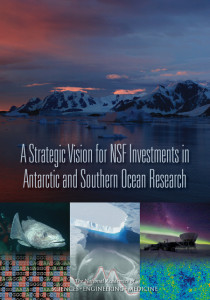Peter Lobner
The National Academies Press (NAP) recently published the report, “A Strategic Vision for NSF Investments in Antarctic and Southern Ocean Research”, which you can download for free at the following link if you have established a MyNAP account:
NSF states that research on the Southern Ocean and the Antarctic ice sheets is becoming increasingly urgent not only for understanding the future of the region but also its interconnections with and impacts on many other parts of the globe. The research priorities for the next decade, as recommended by the Committee on the Development of a Strategic Vision for the U.S. Antarctic Program; Polar Research Board; Division on Earth and Life Studies; National Academies of Sciences, Engineering, and Medicine, are summarized below:
- Core Program: Investigator-driven basic research across a broad range of disciplines
- NSF gives the following rationale: “…it is impossible to predict where the next major breakthroughs or advances will happen. Thus to ensure that the nation is well positioned to take advantage of such breakthroughs, it is important to be engaged in all core areas of scientific research.”
- NSF notes, “…discoveries are often made by single or small groups of PIs thinking outside the box, or with a crazy new idea, or even just making the first observations from a new place.”
- Examples of basic research that have led to important findings include:
- Ross Sea food chain is affected by a high abundance of predator species (whales, penguins and toothfish) all competing for the same limited resource: krill. Decline or recovery of one predator population can be seen in an inverse effect on the other predator populations. This food chain response is not seen in other areas of the Antarctic ice shelf where predator populations are lower, allowing a larger krill population that adequately supports all predators.
- Basic research into “curious” very-low frequency (VLF) radio emissions produced by lightning discharges led to a larger program (with a 21.2-km-long VLF antenna) and ultimately to a better understanding of the behavior of plasma in the magnetosphere.
- NSF gives the following rationale: “…it is impossible to predict where the next major breakthroughs or advances will happen. Thus to ensure that the nation is well positioned to take advantage of such breakthroughs, it is important to be engaged in all core areas of scientific research.”
- Strategic, Large Research Initiatives – selection criteria:
- Primary filter: compelling science – research that has the potential for important, transformative steps forward in understanding and discovery
- Subsequent filters: potential for societal impact; time-sensitive in nature; readiness / feasibility; and key area for U.S. and NSF leadership.
- Additional factors: partnership potential; impact on program balance; potential to help bridge existing disciplinary divides
- Strategic, Large Research Initiative – recommendations::
- Priority I: The Changing Antarctic Ice Sheets Initiative to determine how fast and by how much will sea level rise?
- A multidisciplinary initiative to understand why the Antarctic ice sheets is changing now and how they will change in the future.
- Will use multiple records of past ice sheet change to understand rates and processes.
- Priority II: How do Antarctic biota evolve and adapt to the changing environment?
- Decoding the genomic (DNA) and transcriptomic (messenger RNA molecules) bases of biological adaptation and response across Antarctic organisms and ecosystems.
- Priority III: How did the universe begin and what are the underlying physical laws that govern its evolution and ultimate fate?
- A next-generation cosmic microwave background (CBM) program that builds on the current successful CMB program using telescopes at the South Pole and the high Atacama Plateau in Chile and possibly will add a new site in the Northern Hemisphere to allow observations of the full sky
- Priority I: The Changing Antarctic Ice Sheets Initiative to determine how fast and by how much will sea level rise?
You will find detailed descriptions of the Priority I to III strategic programs in the Strategic Vision report.
